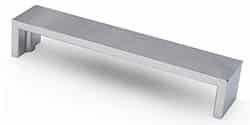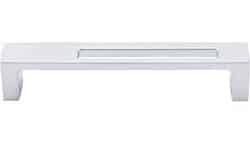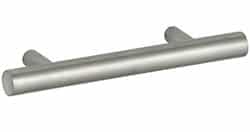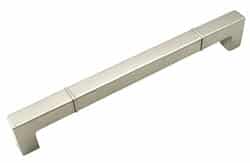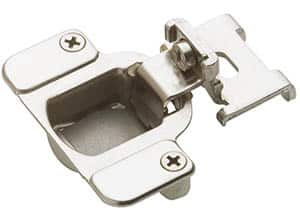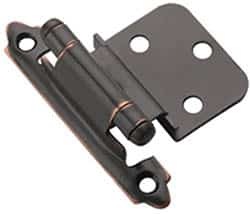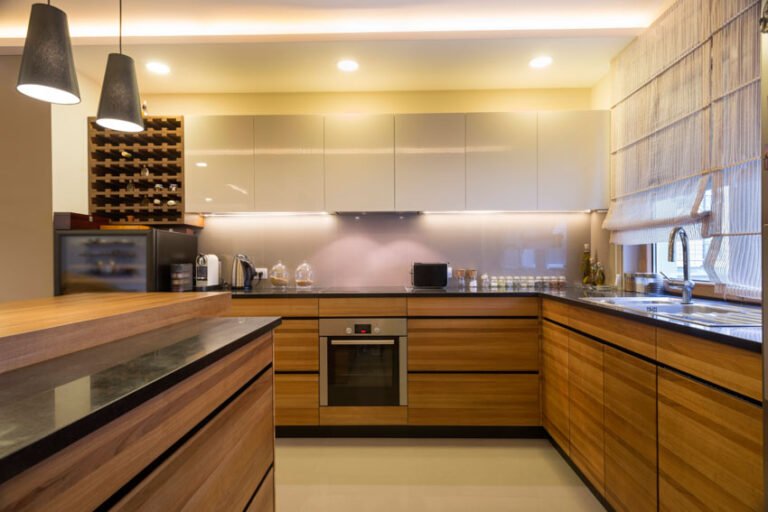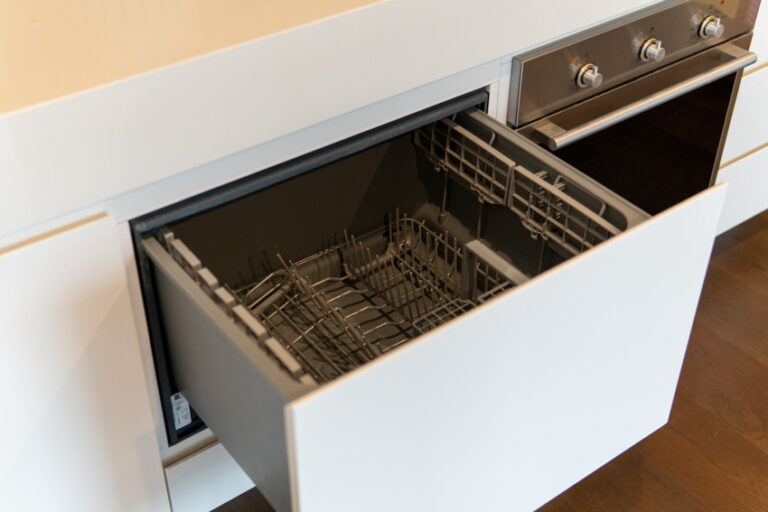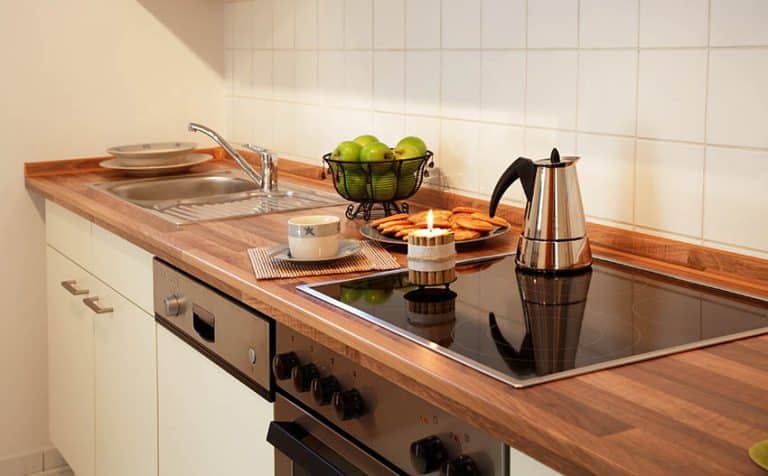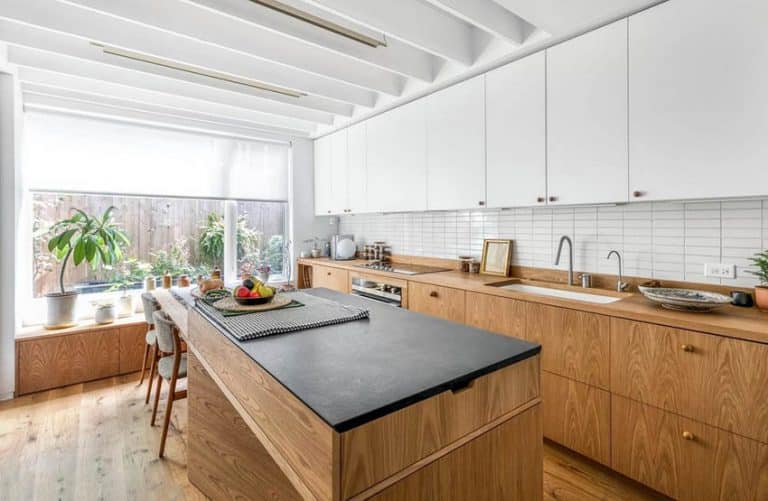European Kitchen Cabinets (Ultimate Design Guide)
Welcome to our guide to European kitchen cabinets including popular types, finishes and hardware.
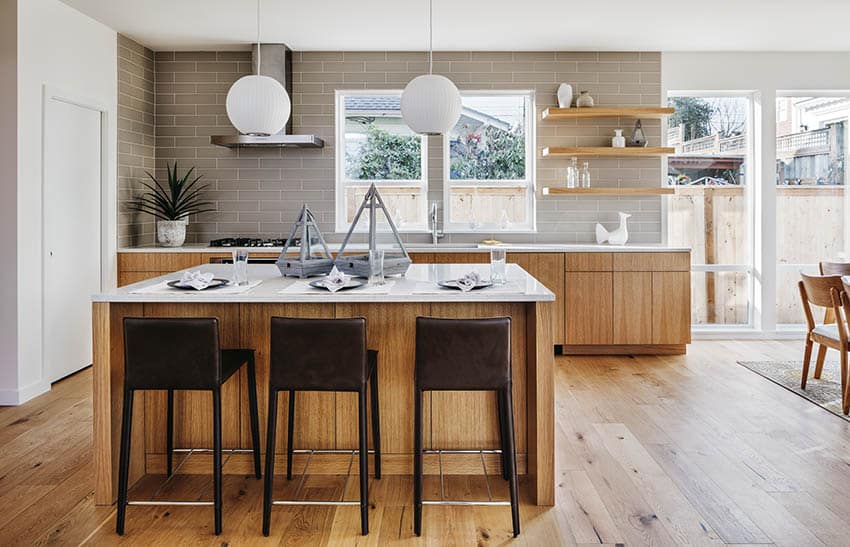
The European kitchen was designed to fit the limited residential spaces in England, Spain and Italy. European flats and apartments were generally smaller in size as compared to an average American apartment, thus the need to build a compact size kitchen which will cater to the daily activities of its occupants. With the real intent of focusing on functionality and efficiency rather than ornamentation, European kitchens were designed as dynamic spaces which cater to the evolving needs of the users – everything was maximized but beauty was never compromised.
Since functionality was the top priority for European style kitchens, every element of the space is selected with care to bring the kitchen to its fullest potential, including the kitchen cabinetry. European style kitchen designers were able to develop a form of kitchen cabinetry which employs a special form of cabinetry construction method, finishing technique and durable material.
Below we explore some of the key design elements of European style kitchen cabinets to help you decide whether their high functionality and ultra sleek character is the right fit for your home. (For more types of cabinetry, see the full gallery of kitchen cabinet styles on this page)
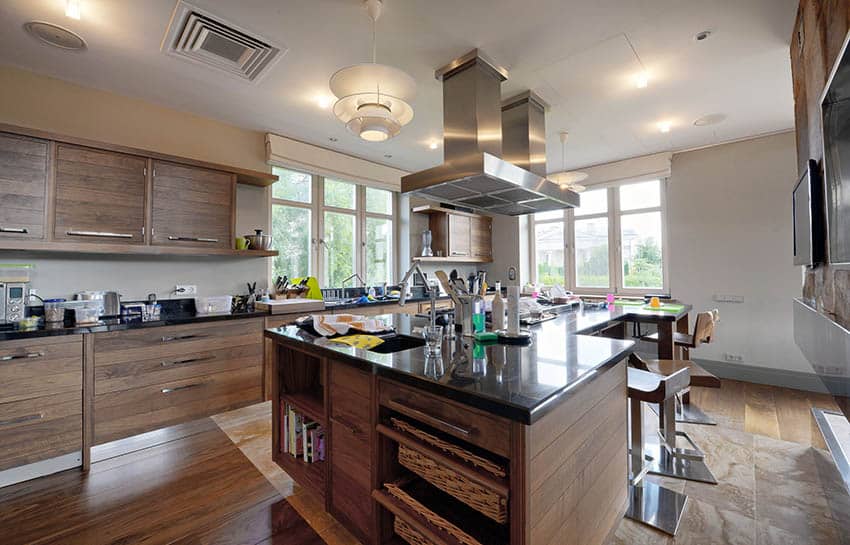
Characteristics of European Style Kitchen Cabinets Design
Sleek appearance – The design for European style kitchen cabinets are ultra sleek, stylish and have a high end appearance. This kitchen cabinet design style resembles the minimalist aesthetics of modern style in such a way that the forms are clean, streamlined and well defined.
Smooth surfaces and textures – The design of European style kitchen cabinets typically feature smooth, flat surfaces which are often characterized by a highly polished texture. This is often reflected through the use of high gloss paints or laminates, metal cabinet hardware, plastics, vinyl and glass. As a result, the flat and smooth surfaces of European style kitchen cabinets can make spaces or small kitchens feel roomier.
Absence of ornamentation – European style kitchen cabinets conform to minimalist design aesthetics and put more emphasis on functionality rather than ornamentation. It is devoid of excess decorations and often feature flat surfaces with no form of detailing such as decorative trims, crown moldings, carvings and raised panels. And just like modern and contemporary kitchen cabinet designs, his kitchen cabinet style often features simple cabinet door styles like the slab style door and the flat panel door.
Straight lines – The design of European style kitchen cabinets focuses on linear forms, angular lines and straight edges. Unlike traditional designs which typically feature arches, graceful lines and highly stylized forms, European style kitchen cabinets have prominent geometric shapes like rectangles.
Neutral and Bold colors – The colors for European style kitchen cabinets range from neutrals like white, gray, taupe and black to bold colors like bright reds, lime greens and oranges.
Full overlay and frameless design – The frameless construction or full overlay design is tantamount to European style kitchen cabinets. Not only does it ensure a seamless look and a more sleek appearance for the kitchen cabinetry but it also increases functionality by providing maximum storage space and aiding in ease of use.
Simple, understated hardware – European style kitchen cabinets make use of sleek, minimalist and understated kitchen cabinet hardware. Cabinet pulls, handles and knobs usually have simple, subtle forms which complement the streamlined appearance of European style kitchen cabinet design. Typically, European style kitchen cabinet hardware have a silver color and is often in polished, brushed or satin finish. These kitchen cabinet hardware are also designed to increase efficiency of use and aid in comfort and convenience.
Concealed hinges – Because of the frameless construction style of European style kitchen cabinets, concealed hinges are commonly used as a form of mechanism for kitchen cabinet doors.
Increased functionality and ease of use – Designed to prioritize the needs of the user’s and with priority over efficiency, European style kitchen cabinets bring maximum functionality through the use of effective storage systems which optimize capacity and organization. There are no awkward kitchen cabinet corners which are inaccessible and no hassle in opening cupboard doors. Its design also incorporate wire baskets and other integrated units which lessen the tendency of digging around to find what you want.
Synthetic materials – Rather than featuring traditional materials like solid woods in natural finishes, European style kitchen cabinets typically employ synthetic materials such as medium density fiberboard (MDF), particle board, plywood or engineered woods for the cabinet carcase or box. While the finishes are typically special and make use of man made materials too like laminates, high gloss paints, plastics, glass and polyurethane.
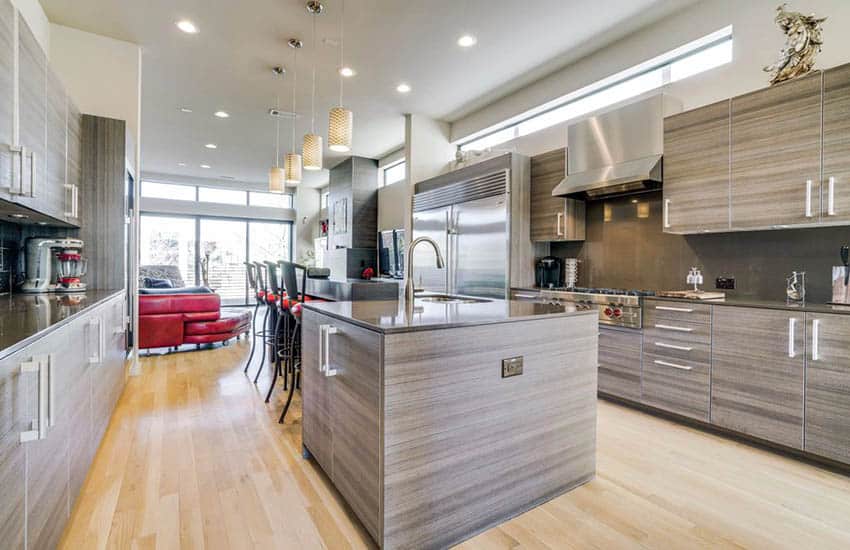
Most materials in European style kitchen cabinets are synthetic as opposed to traditional styles which typically feature natural, solid hardwoods. These materials such as engineered woods, metals, concretes and glass are highly processed to give them a more polished and smooth appearance.
When it comes to the cabinet carcase or box, the main material used for European style kitchen cabinets are engineered woods. This includes plywood, medium density fiberboard or MDF and particle boards. Typically these materials act as a substrate to another finishing material.
You also don’t get to see the wood stain or varnish finish for the European style kitchen cabinet design, but instead modern alternatives such as laminates are used to mimic the appearance of wood grain patterns. The high gloss finish is also another popular treatment for European style kitchen cabinets and this is typically achieved through the use of special paints such as polyurethane, acrylic. Other finishing materials for European style kitchen cabinets include frosted glass inserts, linoleum, lacquer, thermofoil, paint, polyester or acrylic.
Other synthetic materials which are commonly used as complementary decor for European style kitchen cabinets are steel, plastics, vinyl and concrete. Metals such as stainless steel, chrome and aluminum are popularly used for kitchen cabinet hardware and appliances. Backsplash materials typically include plain tiles, graphic coat glass, while the countertops often employ a mix of material choices such as natural stone like granite and man made materials such as quartz.
Since man made materials have the tendency to make cabinetry feel too “stark”, natural finishes are sometimes employed to incorporate a balancing element in the space. Real wood veneers and natural stones help bring back warmth and coziness to the kitchen.
Euro-Style High Gloss Cabinets
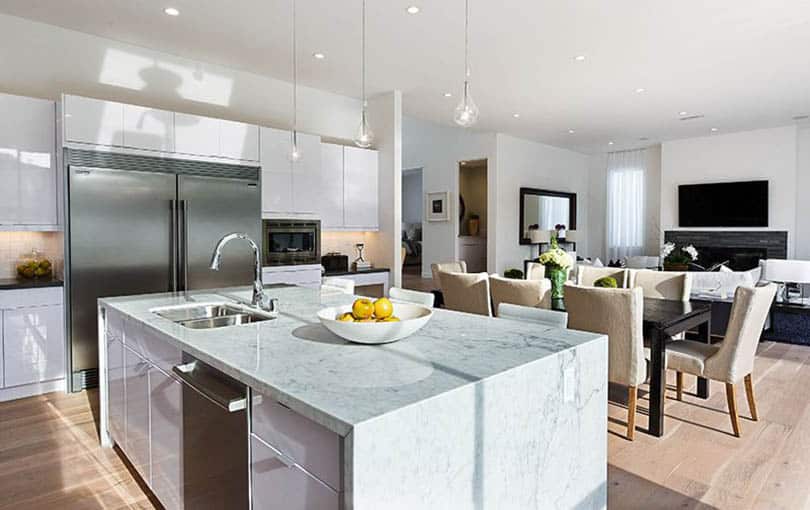
In terms of design, high gloss finish European style kitchen cabinets give a super stylish and contemporary look. It can also give small kitchens a brighter, more spacious and cleaner atmosphere. Aside from increased aesthetic value, the high gloss finish contributes a number of practical benefits in terms of durability and the kitchen cabinetry lifespan. Since it often involves an application of multi layers of paint or a finishing material, the result of a high gloss finish is enhanced resistance to scratches, humidity and chemical agents. This also ensures that the color of the kitchen cabinets do not easily wear off as compared to a regular painted cabinet door. It also aids in creating a hygienic kitchen as it’s very smooth surface will not promote any germ or bacterial growth.
Due to the labor intensive and time consuming finishing process that is involved in manufacturing European style modern high gloss kitchen cabinets, they can get quite pricey and may cost the same as a custom painted cabinetry. But because of their high end looks, luxurious appeal and extreme durability, European style modern high gloss kitchen cabinets are considered to be a worthy lifetime investment which can significantly add value to your home.
There are drawbacks to high gloss finished cabinets though. The finishing process for European style modern high gloss kitchen cabinets is also usually done off site in a manufacturing plant or specialty shop, which means that touch ups and repair may require removing the whole cabinet door then sending it to a shop. Another main disadvantage is that fingerprints, watermarks and dirt are more noticeable on high gloss kitchen cabinets, thus they might require more wiping and regular cleaning.
Finishes for Euro-Designed Cabinets
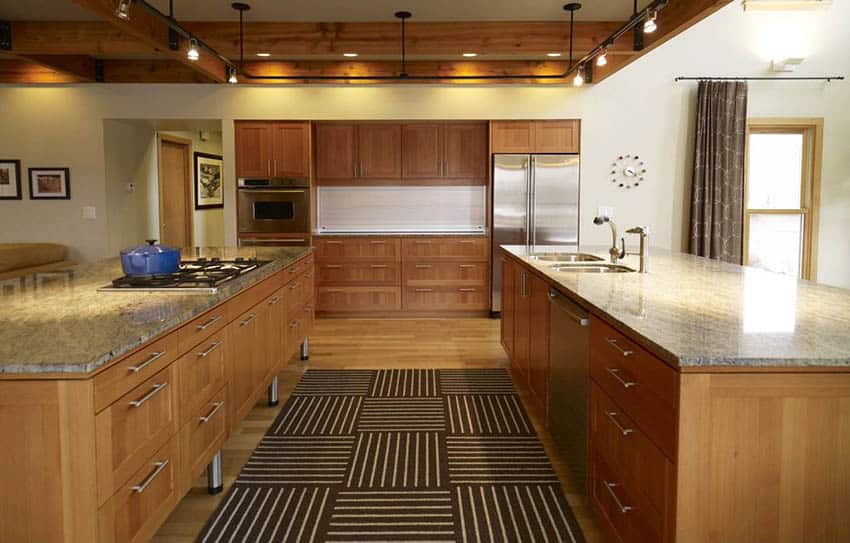
The “high gloss” finish is a signature look of European style kitchen cabinets and this highly reflective surface is achieved through the use of different finishing techniques which require a labor intensive process.Some methods of producing high gloss European style kitchen cabinets are rolling or brushing on coats of high gloss paint, spray painting through the use of a compressor, application of polyurethane,lacquering and laminating. Often times, it requires multiple layers of the finishing material, followed by buffing which follows the same process that is involved automobile manufacturing.
Wood is also a popular finish, but instead of using real hardwoods in their natural, rich colors, the cabinet materials are often treated with finishes that capture and mimic the beauty of real wood, such as veneers or laminates.
There are a number of different materials which can be used to achieve an ultra polished, lustrous surface for European style kitchen cabinets namely duco paints, polyurethane, acrylic, lacquer, foils and laminates.Here are some popular high gloss finishes used in European kitchen cabinet designs:
Acrylic Cabinets
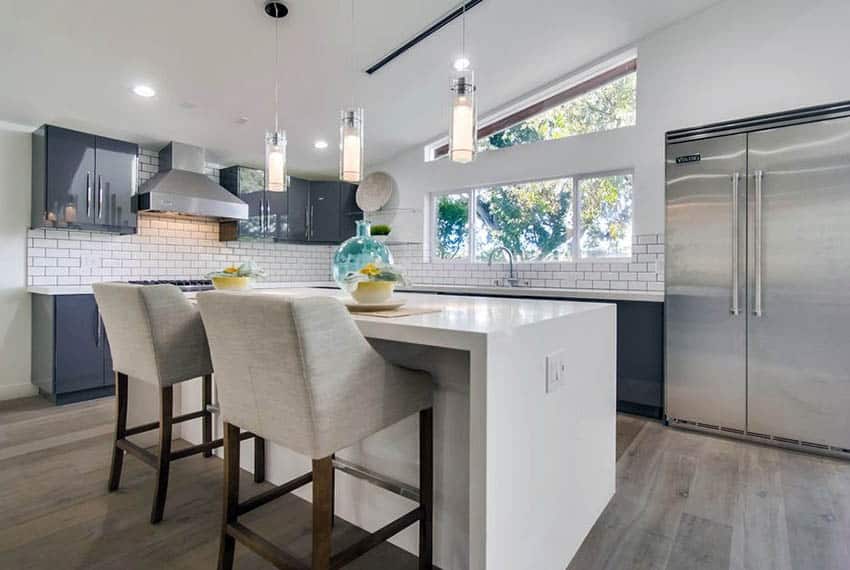
Solid acrylic doors are finished with acrylic through and through, thus they have a more even color and richer appearance, but are relatively more expensive. Acrylic faced doors, on the other hand, are cheaper alternatives because instead of being made up of acrylic all the way through, the doors are just coated with a layer of the material. The process of applying acrylic finish to kitchen cabinet doors is a labor intensive process which involves pasting a sheet of acrylic to a substrate such as medium density fiberboard or MDF, then covering it with a protective layer and sealing its edges.
European style kitchen cabinets which are treated with acrylic high gloss finish do not only bring in increased aesthetic value but also contribute a number of advantages. Aside from creating an ultra inviting atmosphere, acrylic high gloss kitchen cabinets can take in a lot of wear and tear from everyday use because of its durability. In addition, the multi layered finish used for the acrylic finish creates a scratch resistant surface that is better than any other material. In addition, it is moisture, UV light and scratch resistant. Maintenance is also the least of your worries because cleanup is easy and requires only mild soap and water. Above all, acrylic high gloss kitchen cabinets can retain its mirror like appearance, hue and brightness for years without fading.
However there are still a number of drawbacks to this type of European style kitchen cabinet finish. Although cleanup is easy, fingerprints, watermarks, dirt and stains are more visible on a high gloss surface, thus regular maintenance is a must. Its price is also a major consideration because it is more expensive compared to laminates or the membrane finish.
In terms of design flexibility and versatility, the acrylic is at par with other finishes because it is also available in a wide array of color choices which allow for customization.
Thermofoil Cabinets
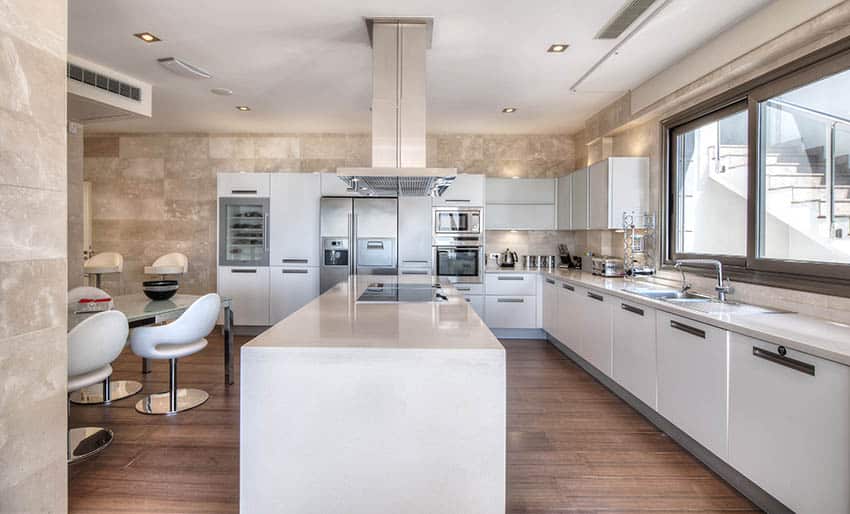
There are a number of advantages to using thermofoils as a finishing for kitchen cabinetry, but the primary reason as to why homeowners get drawn to it is because they require low maintenance. Unlike other finishing materials, thermofoil is strong enough to stand in itself and does not need any protective coating. In addition, thermofoils also have superior moisture resistant qualities which allow them to withstand exposure to humidity and temperature changes.
Most kitchen cabinet manufacturers make use of “high gloss foils” for European style kitchen cabinetry. High gloss foils are coatings which give a reflective and mirror like finish. It is available in a wide range of color and pattern options such as plain solid colors or wood like finishes which allow for maximum customization and personalization. The color of thermofoils, in general, range from neutrals like white to vibrant hues like reds, while the textures may either be matte or glossy. High gloss foils are best used for slab style doors and flat kitchen cabinet designs but it is also flexible enough to be molded into curved forms.
In general, high gloss foils produces a smooth texture and a sleek surface while bringing in a contemporary character to European style kitchen cabinets.The overall result of thermofoil European style kitchen cabinets is also more uniform and even because the color is applied throughout the cabinet’s surface. High gloss foils are best used for slab style doors and flat kitchen cabinet designs but it is also flexible enough to be molded into curved forms.
Laminate Cabinets
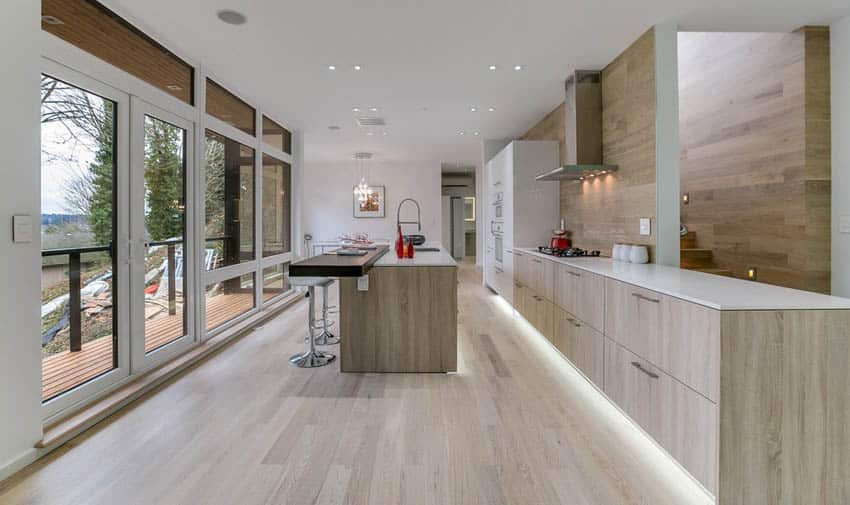
Laminates are the top modern finishing material and it is more widely used in contemporary styles rather than traditional cabinet design. Some popularly know it as Formica – a well known brand of laminates. This thin, lightweight material was once considered to be fragile and unstable but new manufacturing techniques gave laminates an improved quality and a better, stronger and more durable character. The main reason for this durability is its unique material composition. Laminates are highly processed and composed of several layers that are sandwiched together. These four layers include the top layer which is a protective coating of melamine resin, the second layer or decorative layer which contains the design , pattern and texture of the laminate, the core layer which is a resin reinforced Kraft paper, and lastly, the wear layer, which is a combination of aluminum oxides, melamine resins and paper.
For European style kitchen cabinets, laminates are typically applied over the cabinet substrate material which is usually a plywood, MDF or particle board. Heat, pressure and adhesives are used to help fix the material in place, ensuring that it does not easily peel off or chip. For most modular kitchen cabinet systems and manufactured customized high gloss kitchen cabinets, High Pressure Laminates or HPL is more commonly used because it is more durable, long wearing and resistant to damage as compared to regular laminates. When it comes to strength, HPL is comparable to strong countertops.
Laminates are widely available in wood like finishes but are also readily sold in high gloss variants. Its broad spectrum of colors range from neutrals like white, black, gray, taupe to bold colors like vibrant reds, lime greens or oranges which fit the color palettes and striking aesthetic of European style kitchens. The laminated finish works well for European kitchen cabinet style because it creates an evenly smooth surface and a seamless design. The colors are also more uniformed because it is applied in sheets rather than brushing. Overall, the result of laminated high gloss European style kitchen cabinets is a flawless and ultra stylish appearance at a more affordable cost.
In addition to its versatility in design, laminates provide a number of practical benefits such as resistance to fading or warping and ability to withstand heavy use.
Lacquer Cabinets
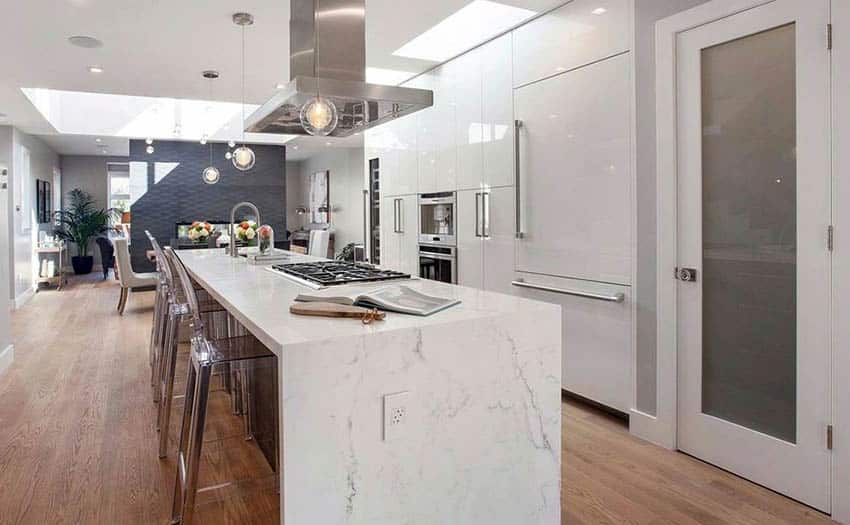
Lacquer is a type of protective finishing material that is made up of shellac and ranges from a clear to colored wood colors. But instead of providing color to kitchen cabinets, lacquer only acts as protective coating or a gloss top coat. The kitchen cabinet materials still need to be painted or treated with a You can use lacquering if you want to stick with the original appearance of your kitchen cabinets but want to give it a sheen. When lacquer dries, the result is an extremely hard and durable surface which allows European style kitchen cabinets to last for years without any damage or breaking.
PVC wrapped, vinyl wrapped and PET rapped gloss kitchen door finish – Among all the available finishes for high gloss European style kitchen cabinets, plastic, vinyl or PVC wrapped doors are considered to be standard” or low quality gloss kitchen doors which are available on the market. Although each of this material has its own advantage, there are still considered to be less durable compared to acrylic, lacquer and laminates.
This kitchen cabinet finish for European style kitchen cabinets is achieved by wrapping an MDF base with a thin layer of plastic such as vinyl or PVC, mixed with with resin, foil or PET (polyethylene terephthalate). Compared to acrylic, polyurethane and lacquered finishes, this kitchen cabinet doors have a less reflective appearance. The major drawback of wrapped kitchen cabinet doors is that its surface may sometimes have a bobbly texture.
However, not all PVC, vinyl, PET or foil wrapped high gloss doors are of low quality. Special modular kitchen cabinet suppliers and kitchen showrooms distribute MDF doors which are treated with thicker finishing materials.
Duco Paint Cabinets
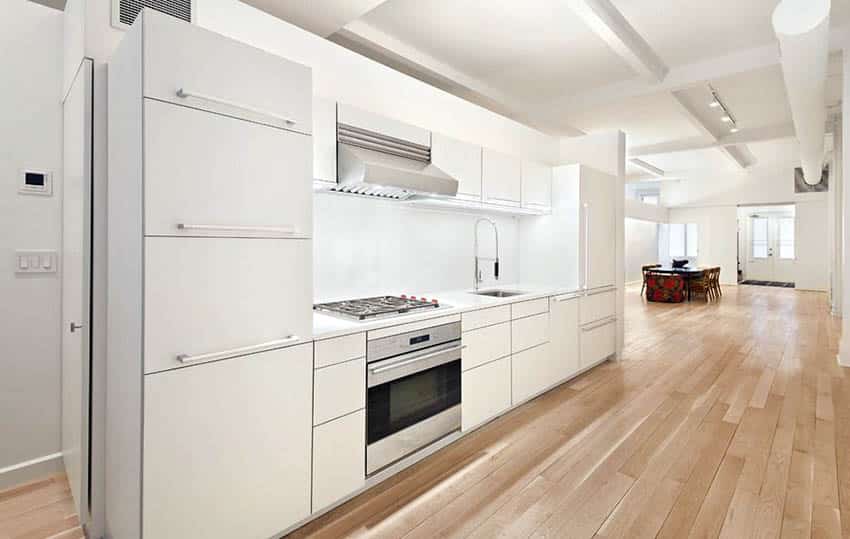
This type of finish conceals the natural graining of the wooden substrate with a coating of opaque paint. The levels of sheen for duco paint finish ranges from flat, satin, semi gloss to high gloss finish. Its application process involves spraying the paint onto the material using a compressor. Some polr types of paint used for duco finish are acrylic enamel paint, water based paints or alkyd paints.
The duco paint finish is more commonly used for furniture manufacturing, however it works well in creating an evenly colored kitchen cabinet surface. This finishing technique is an ideal option if you want to stick to paint but would like to mimic the appearance of high gloss laminated kitchen cabinetry. It also presents a cost effective way to update the look of existing wooden cabinets and transform them into more modern designs.The overall product of the duco paint finish is an even flat surface surface and a clean look which renders an expensive and luxurious feel to kitchens.
Veneer Cabinets
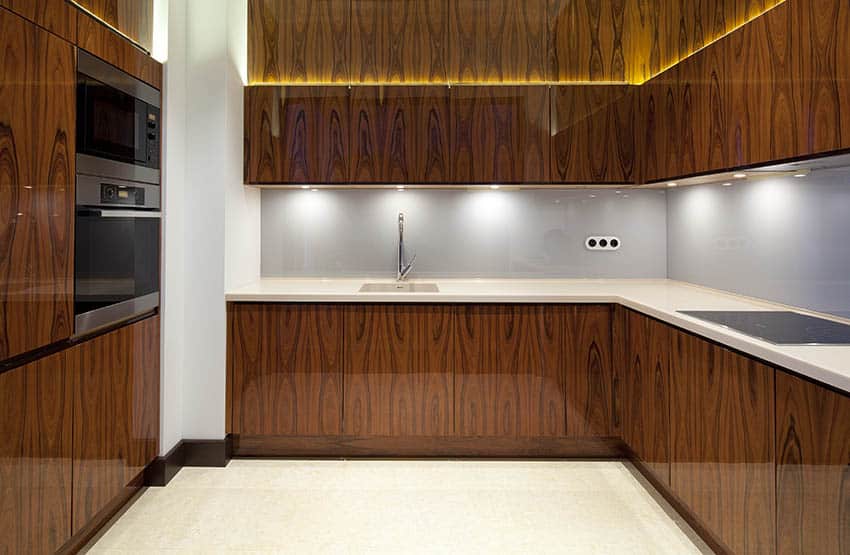
Veneer is also available in different types namely, raw or real wood veneers, paper backed, phenolic backed, laid up, reconstituted or “wood on wood”. Each type has its own pros and cons, but in general, all wood veneers stands up to splitting or warping unlike solid wood. In addition, the glue or adhesive that is used to combine the thin slices of wood together reinforces its strength, making it a durable and long lasting finishing material.
Veneers are best used for European style kitchen cabinets which aim to bring in a warm, welcoming atmosphere into the space. As mentioned, the use of too much synthetic materials can sometimes make a kitchen feel “ sterile” and a good way to tone it down is to bring in a touch of natural wood finish and color. Wood veneers are sometimes regarded as better than other wood like materials because it completely captures the real beauty of wood but reduces the potential drawbacks that come with it. However, compared to other finishing materials, veneer is more expensive.
Rather than being used to achieve a high gloss look, veneers are used for wood grained kitchen cabinets. The overall result is a sleek look because the graining patterns are more consistent. Veneers works best for flat surfaces and for slab style kitchen cabinet doors. The common wood veneers colors that are used for European style kitchen cabinet designs are medium to dark colored woods. And just like contemporary and modern designs, veneers with horizontal graining patterns are also more favored.
Contemporary Euro Inspired Cabinets
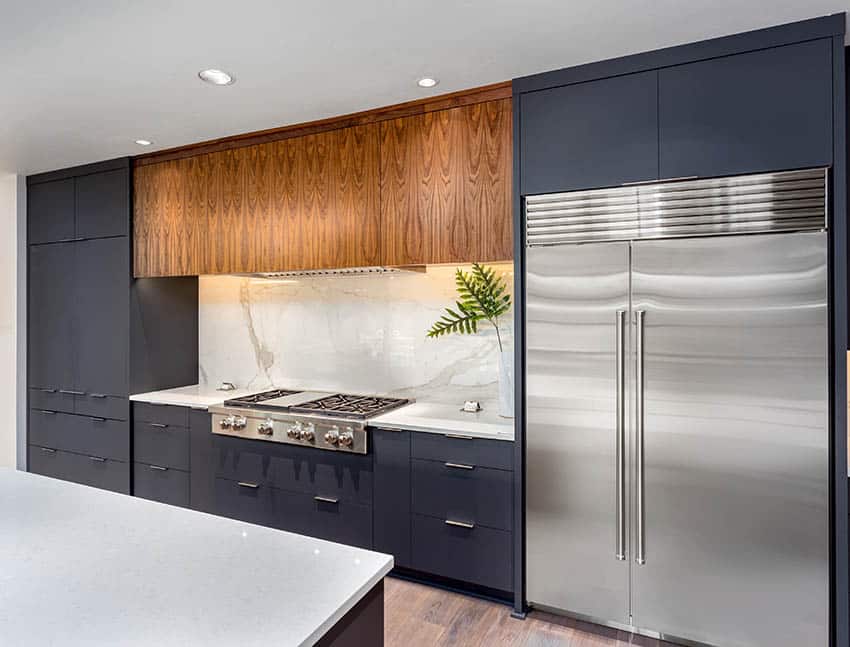
In terms of appearance, contemporary European style kitchen cabinets are more geared towards a wood like look as compared to ultra high gloss solid colors which is often associated with a modern style inspiration. Laminates with horizontal graining patterns are a classic favorite for this Contemporary European style kitchen cabinets. Alternatively, plain, solid neutral colors are also used instead of bold vibrant hues and these options include whites, off white, grays, taupe and shades of brown.
European Design Cupboard Doors
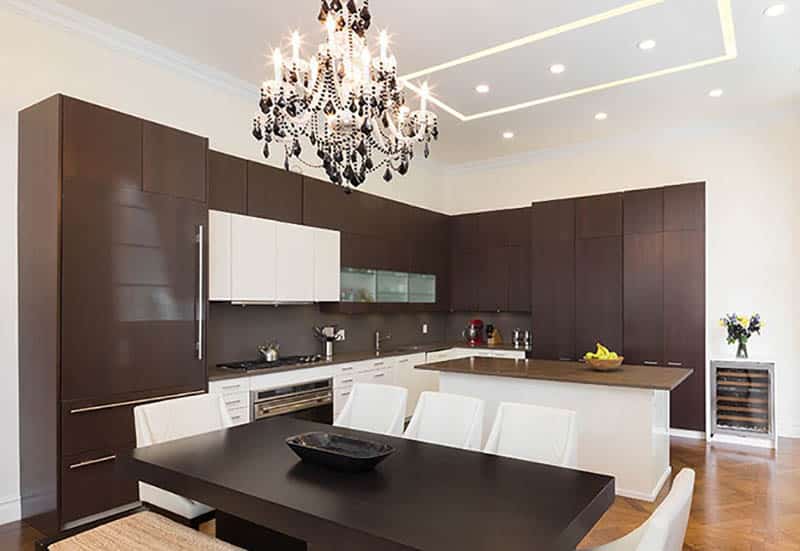
The most common type of kitchen cabinet door style which is used for European style kitchen cabinets are “Slab style doors”. A slab style cabinet door is the simplest and most basic type of kitchen cabinet door available in the market. Slab style doors, as their name suggests, are characterized by a single, solid, unornamented piece or “slab” or flat wood. Its design is basically plain – with no visible embellishments, decorative moldings, edgings, trims, frames or panels
Slab style doors are popular in contemporary and modern kitchen cabinet design but are considered to be the signature look of European style kitchen cabinets. The slab style door is known for its simplicity and frameless appearance which gives European style kitchen cabinets a smooth, sleek and minimalist overall look.
Slab style doors also work best with high gloss finishes because it provides a flat surface to showcase a mirror like finish – there are no mouldings and trims which may interfere with the special finishing. In addition, several European style kitchen cabinet finishes are also more suited for slab style doors as the surface is smooth and won’t force the material to its limits, for example laminates, veneers or acrylic.
Frameless European Cabinets

A standard kitchen cabinet construction typically makes use of “stiles” or vertical members of the face frame and “rails” or horizontal members of the face frame. The stiles and rails make up the front part of the cabinet to which the door is attached. The side panels of the cabinet, on the other hand, are inset and typically attached to the stile and rail. This traditional way of constructing kitchen cabinets is known as the “face frame” construction.
But when it comes to the “frameless” type of kitchen cabinet construction, there are no stiles and rails used but only side panels. The cabinet door is directly attached to the side panels using hinges. And since this type of cabinet construction method does not use a cabinet frame, it relies instead on a thicker cabinet carcass or box construction for stability.
Frameless kitchen cabinets also use “full overlay” doors. Full overlay doors are cabinet doors which are directly attached to the sides of the cabinet box or carcase. This cabinet construction type also incorporates the use of hidden or concealed hinges. Full overlay doors ensure a smooth design by concealing or disguising the cabinet frame behind the cabinet doors.

Framed kitchen cabinets may be ahead when it comes to being sturdy but frameless kitchen cabinets provide much more storage. It does not have any vertical stiles or partitions which make it difficult to store items or full sized dinnerware and kitchen tools. Drawer boxes are much larger as there are no cabinet parts or members which take space. Finally, frameless kitchen cabinets produce a cleaner look. Frameless kitchen cabinetry blend more seamlessly with each other, ensuring a more smooth transition between different elements of the space and promoting a more integrated design which is perfect for the sleek aesthetics of European style kitchens.
Euro Cabinet Hardware (Types & Finishes)

In terms of design, European style kitchen cabinets featured hardware which are similar to those found in modern and contemporary kitchen cabinets – streamlined in form, angular and had no ornamentation. In some cases, there are no cabinet handles featured outside the kitchen cabinet doors to create a more seamless look. This “handleless” design is a feature that is distinct to the European style kitchen cabinets.
There are several types of kitchen cabinet hardware which work best for the minimalist aesthetics of European style kitchen cabinet. Below we explore some of the best designs and finishes along with their characteristics.
Special hardware styles for seamless European style kitchen cabinets design
Here are some several types of kitchen cabinet hardware which help create a seamless European kitchen cabinetry design:
Push latch – A common feature for European style kitchens is full expanse of wall kitchen cabinets that have a smooth, flat surface. In order to achieve this sleek look, European style kitchen cabinets often showcase “handleless design”. In order to provide ease in terms of operation, handleless kitchen cabinets design make use of push latches which aid in opening and closing the cabinet doors.
Push latches are considered to be one of the most well used kitchen cabinet hardware in contemporary, modern and European style kitchen cabinets because it provides a very clean aesthetic. A push latch is a piece of magnetic device that is installed on the cabinet’s interior rather than in front of the kitchen cabinet door. There is no actual piece of metal hardware that is visible on the kitchen cabinet door or drawer face, but instead the mechanism is installed at the back or interior of the cabinet door.
Push latches also provide a number of practical benefits in terms of operation. It offers an easy way to open kitchen cabinet doors as they are operable using only a gentle nudge, push or touch. Just like self closing mechanisms, push latches provide a soft close movement or a slow motion effect in bringing kitchen cabinet doors into a closed position. As a result, a completely closed kitchen cabinet door and a fully seamless kitchen cabinetry design is achieved.

Tab pulls are available in a wide range of designs, finishes and sizes. It can either be small or run the full length of a cabinet door or drawer, but regardless of the choice, a tab pull brings in a refined aesthetic appeal especially if used for modern European style kitchen cabinets. Tab pulls that are bigger in size have a more highlighted appearance and can bring a strong statement in a space.
Stainless steel and metal tab pulls provide a bold contrast when used with the ultra polished surface of high gloss European kitchen cabinetry.
Hidden or edge pulls – In terms of appearance, a hidden pull is highly similar to a tab pull. Hidden or edge pulls are types of kitchen cabinet hardware that are attached to the top edge of the kitchen cabinet door. The design of hidden or edge pulls is usually a small metal that extends out of the flush portion of the kitchen cabinet. Once installed, a hidden or edge pull looks subtle because it is concealed by the kitchen countertop located above the base kitchen cabinets.
The hidden or edge pull provides a clean look that integrates well with the material and aesthetics of European style kitchen cabinets. They perfectly blend with minimalist kitchen cabinetry designs because they have a subtle form and appearance. In addition to their simplified aesthetics, hidden or edge pulls also increase the functionality of below counter drawers and base kitchen cabinets by providing easy access.

Integrated handles come in a variety of materials such as wood and metal and its color may be modified depending on the look you want to achieve for your kitchen cabinets. As mentioned, the overall impact of integrated handles for European style kitchen cabinets will greatly depend on its material and color. If the integrated handle is closely similar to the color of the kitchen cabinets, the result is a more seamless design, but if the materials do not match, contrast is produced. For example, chrome integrated handles paired with glossy white European style kitchen cabinets look like a band of metallic accent that creates stark contrast in the space. While wooden integrated handles paired with wood finish European style kitchen cabinets produces a more seamless appearance and a very smooth transition between the cabinetry and hardware.
There are several types of integrated handles which are commonly used for European style kitchen cabinets namely the C channel metal rail pull and the J channel metal rail pull. These are commonly offered as special options by most modular kitchen cabinet suppliers.

The overall result of using J and C channel metal rail pulls is a very sleek and integrated kitchen cabinet design. Ad since they commonly run the full length of a kitchen cabinet door or drawer unit, the linear form and outline of the European style kitchen cabinets are more emphasized. It works well in providing contrast in terms of texture and material, or in creating a harmoniously seamless look. When used with high gloss European style kitchen cabinets, J and C channel metal rail pulls look like bands of metal accessories which add visual interest to the overall design of the space.
One major advantage of this type of kitchen cabinet hardware is that they lessen the risk of clothes being caught up on handles or waists bumping onto metals as they do not stick out of the surface of the cabinet doors and the drawer faces. It is also easy to operate because of its length and size. However, there is one major drawback to using this type of cabinet hardware. J and C channel metal rail pulls, including other integrated pulls, can easily collect dirt and dust inside the channels or between recessed gap.
Other kitchen cabinet hardware styles for European kitchen cabinet design
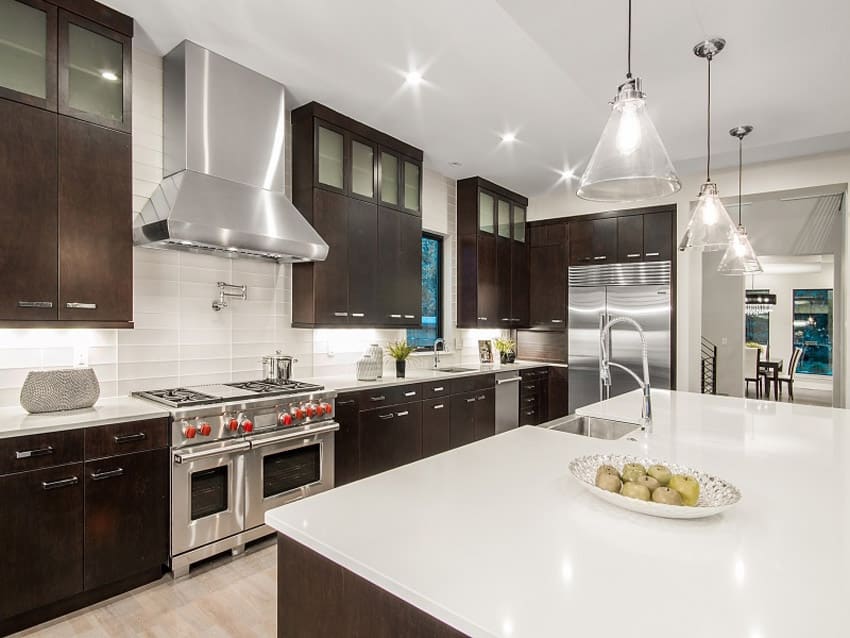
Bar pulls, cut out bar pulls and flat bar pulls all work as statement making pieces ,and rather than blending seamlessly into the kitchen cabinetry design, these three types of hardware are typically designed to stand out.
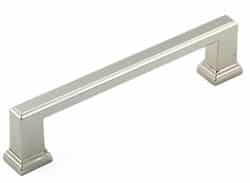
Bar pulls are a staple in European style kitchen cabinet designs because of their simplicity and streamlined figure. This is typically used to complement the designs of flat panel doors and slab style doors. When choosing bar pulls for European style kitchen cabinets, make sure to go with designs that are made up of stainless steel in chrome finish or brushed satin finish.
Flat bar pull
A flat bar bull is a type of cabinet handle that has square edges and a very prominent angular profile. Flat bar pulls are available in different lengths and each size produces a different impact on the overall look of kitchen cabinetry. This type of kitchen cabinet hardware works well with European style kitchen cabinets because they help highlight its streamlined design and brings in a sharp linear accent to the space. Flat bar pulls are well suited for flat panel cabinets and horizontal drawers. For european style kitchen cabinets, make sure to go with long or four finger grip flat bar pulls.
Cut out bar pulls
If you want to add a subtle accent or an extra punch of decor to European style kitchen cabinets, without being too overwhelming, the cut out bar pulls are one hardware options you can explore. A cut out bar pull is a variation of the flat bar pull. In terms of shape and appearance, a cut out bar pull has an angular profile and straight edged design, but instead of having a smooth flat surface, it has a small cut out at the center. The cut out serves as a form of accent or ornamentation and is typically in geometric form, such as a square or a rectangle.
Cut out bar pulls are best paired with flat panel kitchen cabinets or slab style kitchen cabinet doors as they look more noticeable on a plain surface. They are also more prominent over a high gloss finish European style kitchen cabinets as compared to a wood grained cabinets.
Hardware finishes for contemporary kitchen cabinets
Compared to traditional kitchen cabinet hardware which are mostly deep, dark colored with brown undertones, the colors of cabinet pulls, handles and knobs for European style kitchen cabinets are generally silver or grayish and often have a polished finish. The reason being is that these colors match the sharp and bold aesthetics of modern European style kitchen cabinetry very well, which in turn creates an overall ultra stylish design. Most of these kitchen cabinet hardware belong to the polished metal category but their matte counterparts also work well as an alternative.
Here are some example of kitchen cabinet hardware finishes that work best for European style kitchen cabinets:

There are several types of polished finish metal hardware that works best for European style kitchen cabinets. Polished chrome, for example is characterized by a bright silver color that pairs well with sleek kitchen cabinetry. It’s highly shiny appearance contributes a lustrous appeal, thus it can make high gloss European style kitchen cabinets look brighter. Polished chrome kitchen cabinet hardware is best paired with dark colored European style kitchen cabinets as it creates contrast in the space. To enhance its appeal better and to create a stronger and more cohesive look, polished chrome hardware can be combined with matching steel kitchen appliance.

Polished nickel also provides a good way to offset the color and texture of high gloss European style kitchen cabinets, particularly those that are black or dark colored. Above its pleasing aesthetic value, polished nickel also contributes a lot of practical benefits. Known for being one of the most durable types of metals, polished nickel does not weather nor rust, has a longer lifespan compared to other metals and does not require too much touch up.
(See this polished nickel cabinet door hardware at Wayfair)
Brushed metal finish
The brushed finish is also sometimes referred to as the “matte finish” because of its dull polish and soft color. Metals for brushed finish kitchen cabinet hardware are typically subjected to a polishing process that uses a fine bristle brush moving repeatedly in the same direction. Although the metal loses its reflective surface, brushed finish hardware have a soft touch of luster to them. The appearance of very fine lines which indicate the direction of brushing that the material was subjected to also makes its character unique.
A popular example of kitchen cabinet hardware in this finish is Brushed nickel. Brushed nickel hardware is characterized by a soft sheen and compared to polished nickel, this finish has a more subtle appearance. However, just like polished nickel, brushed nickel has the ability to perfectly blend with any type of kitchen cabinet color and finish, rather than standing out. Brushed nickel is also commonly used for dark colored European style kitchen cabinets as it can tone down its overall look.
Satin finish
The satin finish and brushed finish are highly similar with each other, in fact these two terms are commonly interchanged in terms of kitchen cabinet hardware finish. However, there is a very slight difference between the two. Satin finish hardware is characterized by a translucent and frosted “milky” look. Undergoing the same process that brushed metal hardware go through, satin finish subjects metal into brushing with long strokes, but is sandblasted afterwards. The final step (sandblasting) makes all the difference because instead of the appearance of fine lines, any visible pattern is removed and a more randomized look is achieved. Compared to polished finishes, satin finish hardware have a softer look, a more subtle color and more matte surface.
Aside from its unique aesthetics, an added bonus to using satin finish kitchen cabinet hardware is that it is easier to maintain. Compared to its polished counterparts which show off fingerprints easily, satin finish cabinet hardware because do not easily get marks on its surface.
A popular type of satin finish hardware which works well for European style kitchen cabinets is Silver satin. Silver stain kitchen cabinet hardware is characterized by a matte, brushed like surface. Compare to polished silver, silver satin has a more toned down appearance with works well for both light and dark colored European style kitchen cabinets. When matched with high gloss white kitchen cabinets, silver satin hardware. This type of kitchen cabinet hardware finish is typically used as a matching decor to stainless steel appliance. It provides a mellow complementing color to white kitchen cabinets, while works as a good way to offset dark brown and black kitchen cabinets.
Other finishes – Stainless steel and nickel chrome are two other types of kitchen cabinet hardware which fit the modern aesthetics of European style kitchen cabinets.


European Style Cabinet Hinges
Another unique characteristic of European kitchen cabinets are the use of specialized hinges which help provide ease of use and a more seamless design. To achieve a modern, seamless look, the hinges used in European style kitchen cabinets are hidden from plain sight and mounted on the insides of the cabinet. Alternatively, soft close hinges are also used to achieve maximum functionality.
There are several types of hinges which work best with the European kitchen cabinet style. Here is a short overview of their characteristics and positive features:
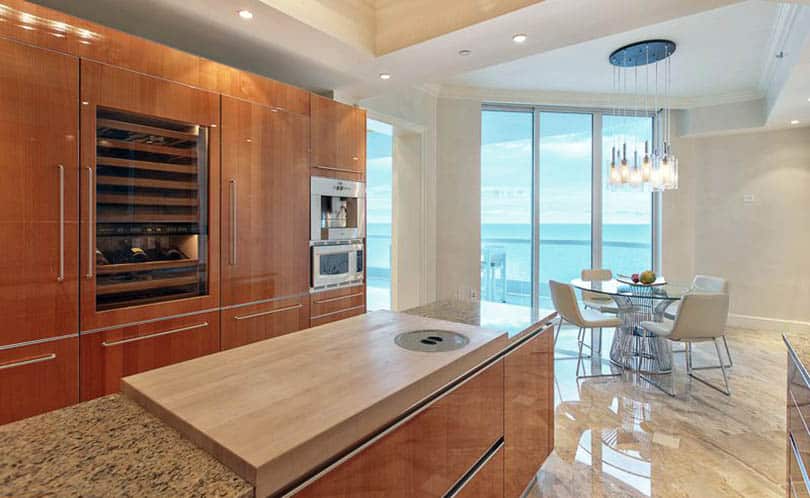
Aside from creating a very pure visual aesthetics, concealed hinges also provide a number of practical benefits to the user of the space. For starters, the cabinet doors are completely adjustable after the hinges are installed. Any minor adjustment can be accommodated easily by just turning the screws using a simple screwdriver. Door alignments to remove gaps between the doors or the cabinet walls are easy to fine tune using a simple motion in two to three directions, thus the result is a more perfectly aligned kitchen cabinetry. Cabinet doors using concealed hinges may also be readily removed anytime using a simplified method which can easily be done by anyone. With concealed hinges, the hardware or hinges itself do not have to be removed from the cabinet door. Concealed hinge also provide more security and contributes to easier clean up of the kitchen cabinet surface. In addition, the cost of kitchen concealed kitchen cabinet hinges are fairly inexpensive.
However concealed hinges present one major disadvantage. Although they are easy to adjust and configure, initial installation may be a bit difficult. As mentioned, a hole needs to be bored on the inside of the kitchen cabinet door and with such, proper tools such as forstner bit, electric drill, drill press and boring machine are required. It may be installed by an average homeowner but only if he or she fully understands the installation requirements and configurations.
Concealed hinges also come in a variety of configurations. There are three basic type of concealed hinges namely full overlay, half overlay and insert. The type of hinge that needs to be used on a cabinet door is determined by the amount of overlay of the kitchen cabinet doors. The overlay refers to the positioning of the door in relation to the cabinet opening.
Full overlay concealed hinges
The full overlay concealed hinge is the most common type of concealed hinge used in European style kitchen cabinetry. It is known for having simple”straight arm design” and is typically used for kitchen cabinet doors which completely overlap with the opening. Typically, full overlay concealed hinges are used on each end of a full run of kitchen cabinets in order to align the left and right side with the jambs. Full overlay concealed hinges also work best for european style kitchen cabinets which are finished with laminates.
Half overlay concealed hinges – Half overlay concealed hinges are typically used for cabinet doors that meet together or for those that are attached to opposite sides of a shared, single middle cabinet partition. Half overlay concealed hinges intended for pairs of kitchen cabinet doors that are found at the middle run of the cabinetry.
Inset concealed hinges
Inset concealed hinges are typically used for inset cabinet doors on frameless designs – wherein the cabinet opening is flushed and sits in the front edges of the cabinet. Inset concealed hinges are best used for kitchen cabinetry which incorporate glass doors.
In terms of installation, European style hinges are typically composed of two parts : the hinge and the mounting plate. The hinge part is mounted on a hole which is usually 25 millimeter to 40 millimeter in size, that is located at the back of the kitchen cabinet door. The mounting plate, on the other hand is installed on the cabinet box or carcase, depending on the type of cabinet construction employed. For European style kitchen cabinets which typically make use of the frameless construction, the mounting plate is typically mounted inside the cabinet carcase or box, particularly the side panel of the .
Soft close mechanisms and self closing mechanisms
Another distinct feature of European style kitchen cabinets are advanced kitchen cabinet hardware and mechanism which aid in easy operation and efficiency of use. Self closing or soft closing mechanisms are cabinet door hinges or drawer slides which give a self closing ability to cabinet doors. As compared to regular hinges and drawer slides, soft closing mechanisms work in a slow motion, eliminating the noise and damaging motion of a slamming door. When kitchen cabinets doors or drawers are forcibly closed, soft closing hinges and glides catches them, slows their speed, then gently guides them back to their closed position all with the use of a spring that controls the kitchen cabinet’s mechanism from the inside.
The self closing or soft closing mechanism also works in such a way that the pressure from the door operation is reduced, so instead of closing fully, a drawer, for example, stops at approximated an inch from the frame before it slowly closes.
The major advantage of self closing and soft closing mechanisms is that they provide ease of use and more functionality. In addition, soft closing mechanisms control noise from doors which slam shut and since it also lessens and softens the impact, the kitchen cabinetry are protected from possible damages in the long run.
See more types of kitchen cabinet hinges here.
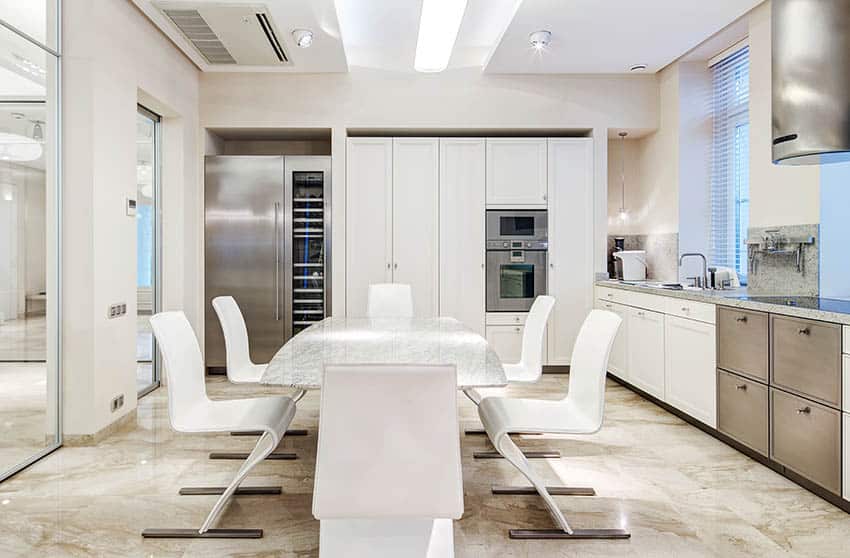
European kitchen cabinets also built up its reputation as a high quality form of modular kitchen cabinetry. In order to promote customization, modular European style kitchen cabinet systems allow homeowners to freely design their own kitchen cabinetry based on their personal needs and specific requirements in the space.
To create a fully personalized kitchen cabinetry with optimum storage capacity and maximum organization, storage units typically featured special accessories. These features may include pull-out plate racks, organized pantry units,s wire baskets, built in trash bins, specialized drawer storage systems, and integrated appliances.

